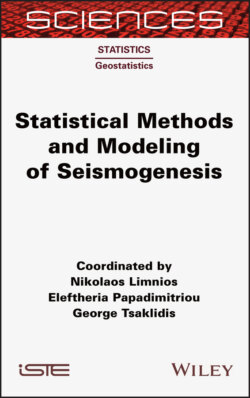Читать книгу Statistical Methods and Modeling of Seismogenesis - Eleftheria Papadimitriou - Страница 34
2.3.5. Application to the seismicity of Central Italy
ОглавлениеThe new version of the simulator code also first applied to another set of the Italian database of seismic sources (DISS 3.2.0), including all the fault systems that are recognized in the Central Apennines, for a total of 24 faults (Console et al. 2018a). One of the main purposes of our application of the simulator to the seismicity of the Central Apennines area was testing whether fault segmentation and characteristic earthquake hypothesis are necessary conditions for modeling, in reasonable way, earthquake patterns observed in real historical records. To show how the un-segmented model of sources used in our simulation can generate realistic seismicity patterns that can be compared with the real seismicity observed in the most recent centuries, we analyzed the complete history of simulated ruptures in a period of 10 kyrs along three faults linked together, along a nearly straight line. For this exercise, we extracted, from a synthetic catalog of 10 kyrs obtained for the complete set of 24 faults, the earthquakes occurring on a fault system including SFS07, SFS08 and SFS09 with a total length of about 170 km (Figure 1 of Console et al. 2018a). The simulator algorithm is not conditioned by the sub-partition of this structure in three faults because their minimum relative distance is shorter than the prefixed limit of 10 km, and ruptures are allowed to propagate from one to another in a unique event.
Figure 2.9. Cumulative magnitude-frequency distribution of the earthquakes in the Calabria region. Red diamonds: synthetic catalog obtained from the simulation algorithm described in the text using a discretization of 0.25 × 0.25 km, an aspect ratio (A-R) coefficient equal to 5 and a stress reduction (S-R) coefficient equal to 0.4; green squares: the Italian historical catalog CPTI11 (Catalogo Parametrico dei Terremoti Italiani) (Rovida et al. 2011) for the latest three centuries; blue triangles: the Italian instrumental catalog ISIDe (Italian Seismological Instrumental and Parametric Data-Base) catalog (Mele et al. 2010) for the latest 20 years. All the three series are displayed in the same units (events per year) (based on Console et al. 2017). For a color version of this figure, see www.iste.co.uk/limnios/statistical.zip
Figure 2.10. Stacked number of M3.0+ events in the 500 years period before and after an M6.0+ mainshock in a 100 kyrs simulated catalog of Calabria region (based on Console et al. 2017)
Figure 2.11. Probability (%) of exceedance of PGA = 0.2 g in 50 years in the Calabria region, obtained from the method described in the text (based on Console et al. 2017)
Figure 2.12. Map of ruptures for M ≥ 6.0 earthquakes on the joint set of three faults of the 24 adopted in the model, in 33 time windows of 300 years represented from top to bottom. The 170 km long fault system is displayed in each panel from left to right moving from NW to SE (Figure 1 of Console et al. (2018a)). On any panel, the level of darkness represents the temporal order of earthquake occurrence, and the amount of slip on multiply ruptured cells (based on Console et al. (2018a))
In Figure 2.12, excluding the events with a magnitude smaller than 6.0, all the larger earthquakes are represented by the cells of 1 × 1 km ruptured in each of them. Each panel from the top to the bottom of the picture shows the events occurred in separate time windows of 300 years with different tones of gray for each earthquake in the same time window. The scale of gray darkness represents the order by which the events nucleated in each panel of 300 years, from the lightest to the darkest, respectively. Multiple ruptures on the same cell in a unique earthquake are represented by darker tones.
By examining Figure 2.12, we note that only three 300 years periods of 33 were lacking any M ≥ 6.0 earthquake, while only two of the other periods contain three earthquakes of such magnitude. There is a clear trend for earthquakes not to occupy the same rupture areas in the same time window, or in consecutive time windows, while they are mostly separated from each other by more than 300 years of several time windows. During the whole test of 10,000 years, every portion of the 170 km long fault system was occupied by at least six or seven ruptures in distinct earthquakes, and none of them was left empty. This is consistent with the recurrence time of 500–1,000 years characterizing the three faults considered in this test.
From the results of this exercise (see Figure 2.12), we can infer that the segmentation scheme mainly based on historical records of earthquakes occurred during the latest centuries could have likely been conditioned by the particular pattern of ruptures exhibited by a group of sources in this relatively recent time window.
